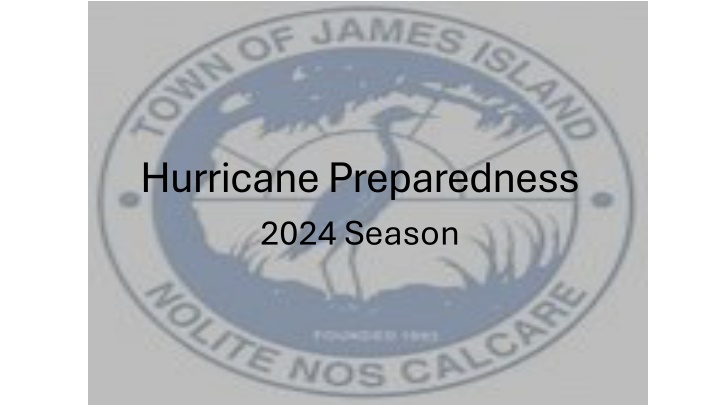
Hurricane Preparedness for 2024 Season: Tips and Information
Learn about hurricane preparedness for the 2024 season, including information on tropical cyclones, evacuation routes, first responders, storm categories, NOAA predictions, and more. Stay informed and be ready to face any challenges that may arise during this hurricane season.
Download Presentation

Please find below an Image/Link to download the presentation.
The content on the website is provided AS IS for your information and personal use only. It may not be sold, licensed, or shared on other websites without obtaining consent from the author. If you encounter any issues during the download, it is possible that the publisher has removed the file from their server.
You are allowed to download the files provided on this website for personal or commercial use, subject to the condition that they are used lawfully. All files are the property of their respective owners.
The content on the website is provided AS IS for your information and personal use only. It may not be sold, licensed, or shared on other websites without obtaining consent from the author.
E N D
Presentation Transcript
Hurricane Preparedness 2024 Season
Hurricane Preparedness Introduction Information about Tropical Cyclones Before the storm Know your NEW Evacuation Zone Evacuation Route After the storm Important resources Questions
Introduction Chris Seabolt, former Fire Chief JIPSD 30+ years in Emergency Service with 23 on James Island Tonight, we will be discussing: Hurricane Preparedness 2024 Hurricane Season Main First Responders JIPSD Fire Department, Solid Waste, and Wastewater Services Charleston County Sheriff s Office Charleston Emergency Medical Services
Tropical Cyclones Tropical Depression-the weakest tropical cyclone having maximum sustained winds of 38mph or less Tropical Storm-mid-level tropical cyclone having maximum sustained winds between 39 and 73mph Hurricane-the strongest tropical cyclone having maximum sustained winds over 74mph Hurricane Alan in 1980 had the highest recorded winds of 190mph
Tropical Cyclone Saffir-Simpson Scale
Tropical Cyclones Watches and Warnings Watches are issued 48 hours prior to expected landfall of a tropical cyclone Warnings are issued 36 hours prior to expected landfall of a tropical cyclone Storm Surge-the abnormal rise in sea level during a storm, measured as the height of water over the predicted astronomical tide. Causes more deaths than high winds The highest recorded storm surge in South Carolina was during Hurricane Hugo in 1989 in McClellanville and exceeded 20 feet
Tropical Cyclones NOAA 2024 Predictions 85% chance of being above average this year Forecasting between 17 and 25 named storms Between 8 and 13 hurricanes And between 4 and 7 major storms (Category 3 or higher) This is the highest number of named storms and major hurricanes forecast ever issued in May An average season is considered to have 14 named storms, 7 hurricanes, and 3 major hurricanes 2020 has the record for the most named storms at 30
Before the Storm Check Homeowner s Insurance Regular policies do not cover flood damage from Tropical Cyclones Investigate the National Flood Insurance Program Flood policies can take 30 days to take effect once purchased Develop an Emergency Communications Plan Create a plan to reunite family members if separated during an emergency Ask an out-of-state family member to be a point of contact Make sure all family members have important numbers and contact information
Before the Storm Create an Emergency Evacuation Plan Determine a location to evacuate Determine when to leave Determine who will go with whom Follow evacuation routes Be able to respond Teach family members how to turn off gas, water, and electricity Teach children how and when to use 9-1-1
Before the Storm Create an Emergency Supply Kit Minimum of 72-hours worth of supplies, as it may take a while to get to you due to flooding or damage Include items like: Water and Non-perishable food Cash and Important Documents Toiletries and toilet paper Medicines and a first aid kit Pet food and medication Batteries, battery-powered lights, and a NOAA weather radio Phone or other types of chargers Extra clothing
Before the Storm Prepare your home Check roof and roof sheathing Secure garage doors Secure storm shutters or board windows Secure any loose outdoor materials, such as: Garbage cans Outdoor furniture Plants Check generator (if you have one) and make sure you have extra fuel
Know your NEW Evacuation Zone The state has developed new evacuation zones for 2024 James Island is now in Zone B we used to be in Zone A
Know your Evacuation Route Residents of James Island are directed to use Folly Road (SC 171) to Savannah Highway South (US 17) to I-526 to the reversed lanes on I-26 The lanes on I-26 are typically reversed sometime after the governor has issued a mandatory evacuation order and all appropriate resources are in place
After the Storm Wait for All-Clear notice to be given to return Re-enter your home carefully Stay away from downed powerlines and any water near them Do not attempt to traverse flood waters as they may be deeper than you think Stay out of flood waters as they are likely contaminated Beware of snakes or other animals that may have been driven to higher ground because of flooding
After the Storm Make sure to clean and disinfect anything in your home that got wet Use appropriate personal protective equipment (PPE), gloves, boots, safety glasses, masks, etc. when cleaning or removing debris Make sure you have been properly trained in the use of equipment like a chainsaw if you intend to use it Do not operate generators, grills, etc. inside a home, or garage, or any enclosed space
After the Storm Use good storm debris management by separating debris using the CHEAT method C-Construction Waste H-Hazardous residues E-Electronics A-Accessories T-Trees and vegetation Place debris Within 15 feet of roadway Between road and sidewalk, if there is one
Important Resources Important links www.jamesislandsc.us/emergency-preparedness www.jipsd.org www.charlestoncounty.org/departments/emergency-management www.scemd.org Important phone numbers 9-1-1 for emergencies (843) 795-4141 Town of James Island (active during emergencies) (843) 743-7200 Charleston County non-emergency Public Safety
Questions Any questions?






















